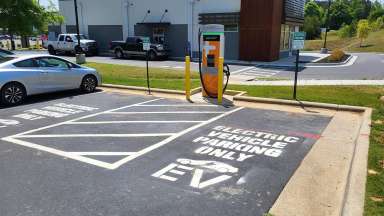Jump To:
The Clean Transportation Ordinance (TC-3-23) is a package of amendments to the Unified Development Ordinance to help implement the Community Climate Action Plan (CCAP) by reducing vehicle miles traveled, making walking and other non-car transportation easier, and supporting vehicle electrification.
This package meets the main objectives of the CCAP: to reduce greenhouse gas (GHG) emissions, address equity, and build community resilience. Specifically, it involves improving pedestrian connectivity requirements, prohibiting new drive-thrus in downtown and other walkable places (existing drive-thrus can remain), and requiring EV infrastructure in apartment buildings, hotels, standalone parking lots, and fuel stations. The ordinance goes into effect on July 4, 2024. Each specific component is described in more detail below:
Drive-Thrus
To support walkability and reduce vehicle idling in downtown and emerging walkable districts, TC-3-23 prohibits new drive-thrus and drive-ins from being established in the Downtown (DX), Office Mixed Use (OX), and Residential Mixed Use (RX) zoning districts and any district with an Urban Frontage.
The DX and Urban Frontages are applied to areas where the highest levels of walkability exist or are planned for in the future. By contrast, the Office and Residential Mixed-Use districts are intended as transitional districts between more intense commercial districts – districts that allow, for instance, standalone restaurants or fuel sales – and more residentially-focused districts. These previously had prohibited drive-thrus/drive-ins for all uses except office uses, which generally means banks.
Regardless of zoning classification, the ordinance does not prohibit drive-thrus/drive-ins in association with pharmacies.
Existing drive thrus/drive-ins can continue to operate, however, there are limitations on their expansion and resumption of drive-thrus/drive-ins that are abandoned or discontinued for an extended period of time.
Electric Vehicle Capable Parking
EVs are a critical part of reducing Raleigh’s GHG emissions. Over 90 percent of charging happens at home, so access to home charging is important to broaden access to the benefits of EVs. These benefits include higher reliability, less maintenance, lower fuel costs, and participation in the transition to clean transportation. This has equity implications, as residents of detached homes, who tend to be wealthier, can add charging at any time. However, apartment residents, who make up a substantial portion of city residents, cannot do so.
To support the ability for all city residents, including those in multifamily housing, to have the opportunity to own an EV and avoid future retrofitting costs, TC-3-23 requires that 20 percent of all parking spaces provided are EV Capable. This term refers to spaces that are connected by a conduit to an electrical panel or panel room with sufficient space to accommodate future charging and wiring. The chargers and wiring are not required to be installed.
This requirement applies to the following uses and building types: apartments, hotels, standalone parking, dormitories/fraternities/sororities, and gas/fuel stations. The requirement also can also be met by providing two installed chargers if 15 percent of spaces are EV Capable.
The requirement does not mean that the site must have the electrical capacity to install future chargers – i.e. transformers or other electrical infrastructure – at the time of construction. Instead, property owners or managers can add upgrades if and when needed over time. Duke Energy has staff who can provide technical guidance on installing conduits and/or planning for future upgrades.
Duke Energy has programs that pay for a portion of the cost of installing EV charging or EV infrastructure. More information is available here: Commercial Charger Prep Credit - Duke Energy (duke-energy.com). More general information about EV charging planning, permitting, and installation is available in the city’s EV Ready Playbook.
Pedestrian Connections
To improve the ability for residents in existing and new neighborhoods to walk and bike to destinations, TC-3-23 requires pedestrian connections between new and existing development. Making it easy to walk to nearby destinations will improve community health, increase pedestrian safety, and reduce carbon emissions and other air pollutants.
The block perimeter requirements are intended to improve connectivity by limiting the size of City blocks. The code currently contains specific exemptions in which no street must be constructed/stubbed to adjacent property. TC-3-23 now requires a pedestrian connection except in the following limited circumstances:
- The connection would be obstructed by:
- Primary Tree Conservation Area
- Railroad or controlled access highway
- Watercourse with at least one mile of drainage area
- Existing improvements where the value of such improvements is more than twice the land value of the parcel on which the improvements are located.
- The property to be developed, or the adjacent property, contains one or more of the following land uses: cemetery, landfill, police station, fire station, EMS station, prison, or any residential use in a detached, attached or tiny house on lots less than 2 acres in size.
This connection would generally need to meet the requirements of a Pedestrian Passage as set forth in UDO Section 8.5.8. and would be located within a public access easement.
In addition to these modified block perimeter requirements, subdivisions adjacent to existing greenway trails must provide one connection every ¼ mile except in the following limited circumstances:
- In the R-1, R-2, Heavy Industrial, and Agriculture Productive zoning districts.
- A subdivision in a Residential (R-) district where there are fewer than four lots per acre.
- For any subdivision smaller than two acres.
- If the connection would require crossing a USGS blueline stream.
